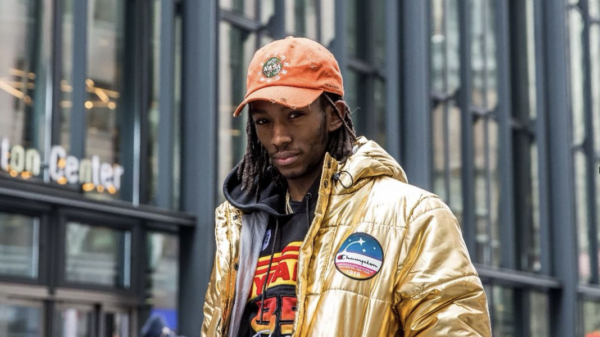Kendrick Lamar played on the term “the Great American Game” with a polarizing, Samuel L. Jackson-narrated performance that felt like a Spike Lee Joint in music form. Like every Kendrick Lamar offering, the 13-minute set left observers with a lot of takeaways — but they aren’t all good things. Some found his commentary on the Black American experience as poignant, while others saw it as heavy-handed.
The discourse is all over the place, but Kendrick’s ability as a performer is undeniable. There were no backing vocals here. Kendrick marched up and down the Superdome stage more effectively than any player on the Kansas City Chiefs, rapping his vocals without missing a beat. His mic was low throughout his performance, but he still made the most of the moment with clarity, precision, and boundless energy. During his “Not Like Us” performance, right after delivering the line, “Say, Drake,” he intentionally stared at the camera with a sneer that Drake will surely never forget (if he’s ever feeling masochistic enough to watch the performance). I’ve seen Kendrick perform several times; the most impressive thing about his live show is how he methodically chews through an hour of rapid-fire, tongue-twisting lyrics. The same was true in his condensed Super Bowl halftime set; the only thing he omitted was calling Drake a “pedophile,” and that was on purpose.
It’s exciting to see hip-hop get played on the world’s biggest concert stage. The genre’s Super Bowl precedent was set in 2022 with Dr. Dre’s extravaganza, where everyone from Eminem to Snoop Dogg and even Kendrick rapped their biggest, most widely recognizable hits. On Sunday, Kendrick took the show in a different direction. He rapped a still-unreleased song, album cuts “DNA” and “Man at the Garden,” and a quick verse over beatboxing. Despite the outrage of right-wingers over the performance, hip-hop was in the house.
Sunday’s set subverted the traditional “just the hits” halftime show approach to tell a story, centering commentary and symbolism at the core of the set. For many, the rubric of success wasn’t the quality of Kendrick’s performance but the effectiveness of his message. The premise for his set was the Black American experience being akin to playing “the Great American Game” of trying to outrun racism à la Jalen Hurts eluding a rush. It’s fitting that he crafted the theme for a football game, where some drives start five yards away from the end zone, and others start 99 yards away. Similarly, in America, opportunity is unequal by design.
Editor’s picks
Kendrick is one of hip-hop’s great conceptualists, often taking years away from music before returning with a new set of meticulously organized songs. Most of his albums present overarching themes interwoven by skits and co-stars like Eckhart Tolle and his fiancé Whitney Alford. Unsurprisingly, he took on the Super Bowl with the same perceptiveness. Sunday’s set wasn’t just him reeling off his most-streamed hits; songs like “Alright” were skipped in lieu of tracks that he feels fit the story of playing “the game.” “Man at the Garden” is an introspective affirmation that we “deserve it all,” while “DNA” was important for him to hammer home the consequences of “war and peace” co-mingling into the Black American psyche.
But, concept be damned, he knew there was one song that had to be in the set: “Not Like Us.” The record-breaking victory lap, which lambasted Drake and had everyone and their Presidential candidate’s mother co-opting the phrase, has been an unprecedented rap phenomenon. We’d never seen a diss song with the legs of the Drake-toppling smash, and fans were eager to see its impact punctuated on the Super Bowl stage. Some viewers tuned in just to see if Drake would get called a “certified pedophile” on the world’s biggest stage. While that didn’t happen, the crowd of 65,719 people got to scream “a minor” to the awe of Tyga and many other attendees. If nothing else, Kendrick got the chance to throw the last bit of dirt on the Drake era.
Related Content
“Not Like Us” was the highlight of a set that lulled a bit in the middle. SZA’s mic was definitely on during her guest appearance, but her and Kendrick’s slower tracks bogged down the energy. We get that he and SZA are about to embark on the Grand National tour, but slowing the vibes down for four minutes of a 13-minute set was a bit much. Samuel L. Jackson, a.k.a. “Uncle Sam,” narrated the set. He played a role similar to his portrayal of Dolmedes in Spike Lee’s Chi-raq. Serving as an avatar for the American establishment, he chastises Kendrick as “too loud, too reckless — too ghetto!” near the start of the set. By the time Sam is set to give Kendrick his approval, noting, “That’s what America wants! Nice and calm. You’re almost there, don’t mess this— ” Kendrick cuts in with “Not Like Us,” which exasperates Sam and causes him to walk offstage.
The show’s base was a giant board with PlayStation buttons on each corner, furthering the “game” symbolism. Tennis legend Serena Williams crip walked during the set as a shot at her rumored ex Drake, and a reminder of her trouble “playing the game” despite her on-court excellence. In 2012, she was essentially called “too ghetto” by detractors for crip walking at Wimbledon. Throughout the performance, Kendrick is joined by dancers in red, white, and blue outfits who eventually take the shape of a flag around Kendrick, symbolizing that Black Americans are the foundation of the country’s development. Later, the dancers split up and lay on the ground, akin to visual artist Keith Haring’s dancing figures; viewers are left to ponder the meaning of the symbolism. And though his overall message was inherently critical of America for putting Black people through the wringer, the image of him steeped in a flag nonetheless feels like him amplifying nationalism.
It’s fitting that Kendrick stood in the middle of a split flag during “Humble,” with people on either side of him. His adherence to the flag as a beacon of Black American pride feels parallel to the “across the aisle” pageantry American politicians periodically share. Kendrick, like Democrats and Republicans serving the American empire, proposes the same thesis: No matter how much we’re at odds, we’re all proud Americans. The flag is a cogent visual metaphor. The rap superstar turned the Super Bowl stage into a giant game but didn’t suggest how to win. Similarly, Black America has varied definitions of victory in this society. To those who strive to succeed within the existing system, the idea of “reclaiming” the flag is resonant. But for those who think we need to figuratively unplug the game and consider a more equitable mode of living, displaying the flag in any reverent fashion is a misstep.
Last year, I criticized Kendrick for using a giant flag in a teaser for the performance because it symbolizes imperialism. And the same is true of the human flag he displayed. There’s nothing to “reclaim” about a flag established when Black people were not even considered fully human at this country’s founding. Amplifying the flag, even while critiquing it, is akin to a subscription to the American project. For Kendrick, a rich celebrity, that alignment is a fine proposition. But for millions of poor people whose rights are being assaulted by President Trump daily, it’s a less avid endeavor. Throughout the 2010s, celebrities ran amok with political symbolism that cued to pro-Blackness and radical ideas. It scratched an itch at one point, but so many people desire more probing art that meets our dire moment. Kendrick is great at presenting imagery that, at times, feels representative of our plight but doesn’t demand from the systems he’s critiquing. But once police buildings started burning in 2020, the bar for genuinely radical symbolism raised exponentially.
The disconnect between our desires and the toothless symbolism celebrities offer underscores that, ultimately, the problem isn’t their execution but our expectations. An Apple Music-sponsored, NFL-sanctioned performance will never be ground zero for radical imagery or messaging. Sure, “Uncle Sam” referenced the revolution being televised, but it just sounded good; Kendrick shouldn’t have been expected to call for anarchy. During Kendrick’s performance, activist Zül-Qarnain Nantambu pulled out a custom-designed flag that highlighted the ongoing genocides in both Gaza and Sudan. He was run off the stage and detained, though not charged. He’s also been banned from future NFL events. Yesterday, he told The Intercept that he asked himself, “Are you going to be brave? Are you going to be a coward? Are you going to take a stand?”
And no matter how fun the Super Bowl halftime show spectacle gets, we should never forget that all these recent selections are rooted in the NFL’s agenda to placate Black people who boycotted Colin Kaepernick, who was blackballed after taking a stand by kneeling during the national anthem. When it comes to genuine radicalism, we should look to the people who the establishment is punishing, not the ones they giddily present to us.





























